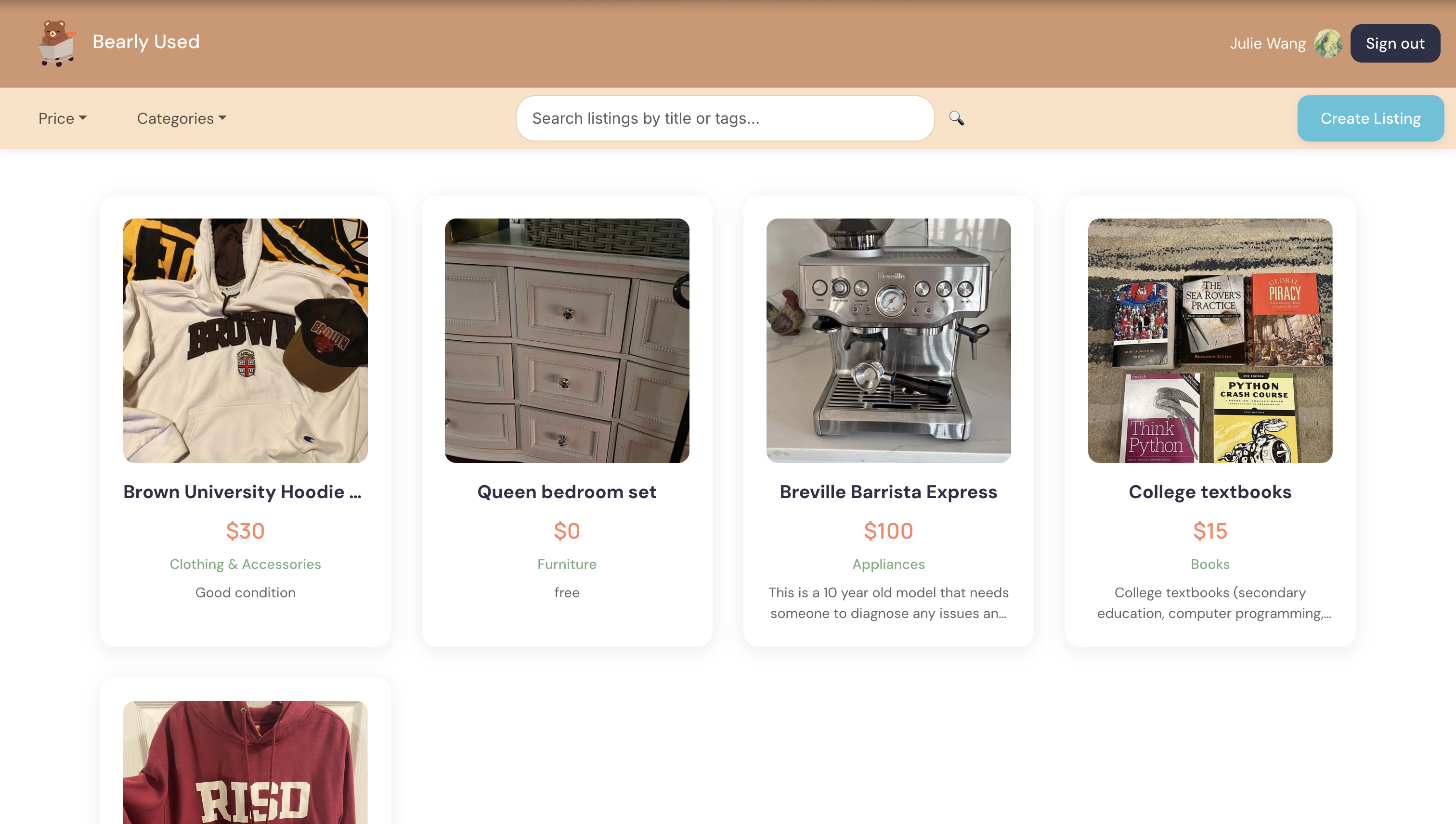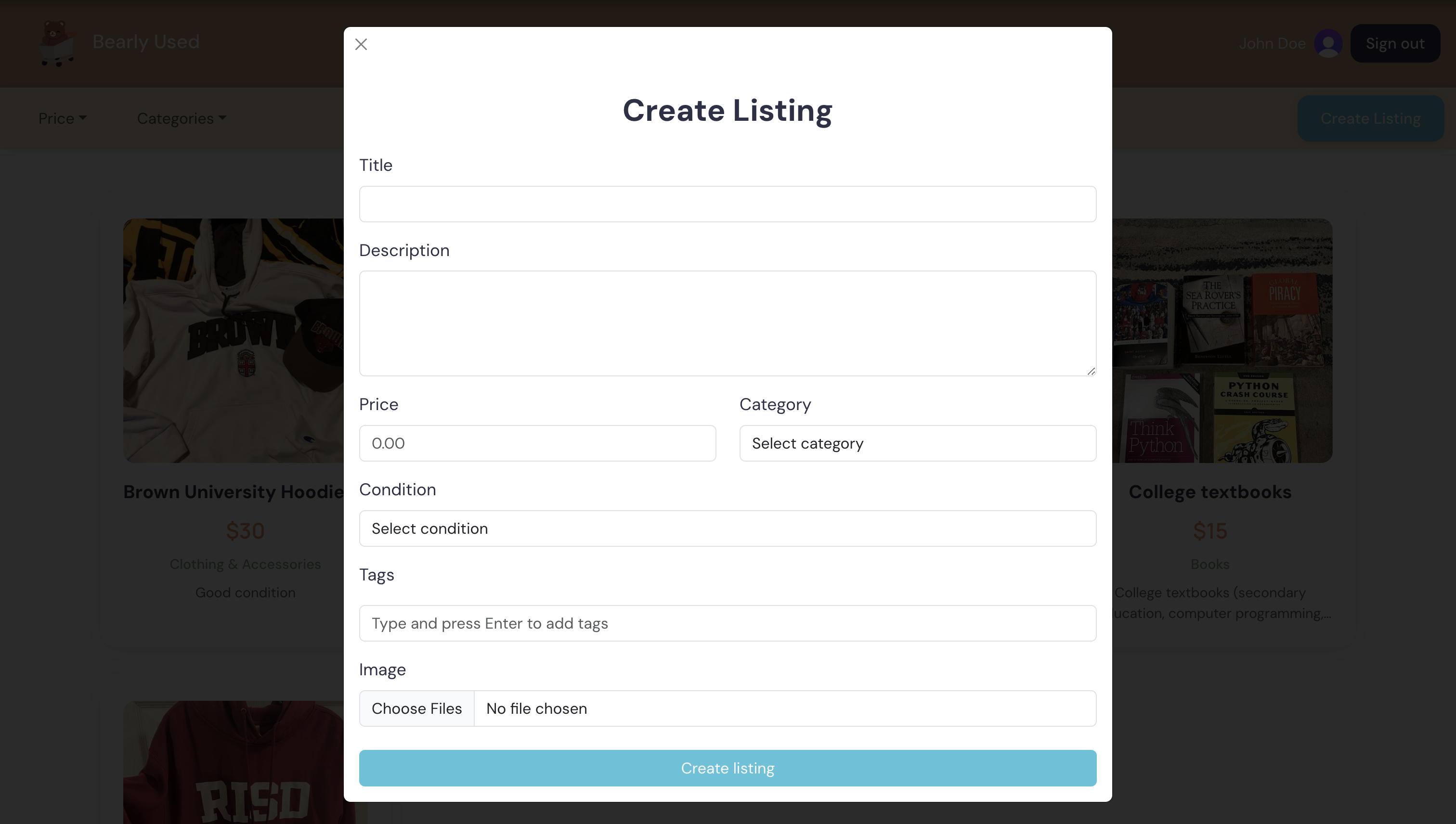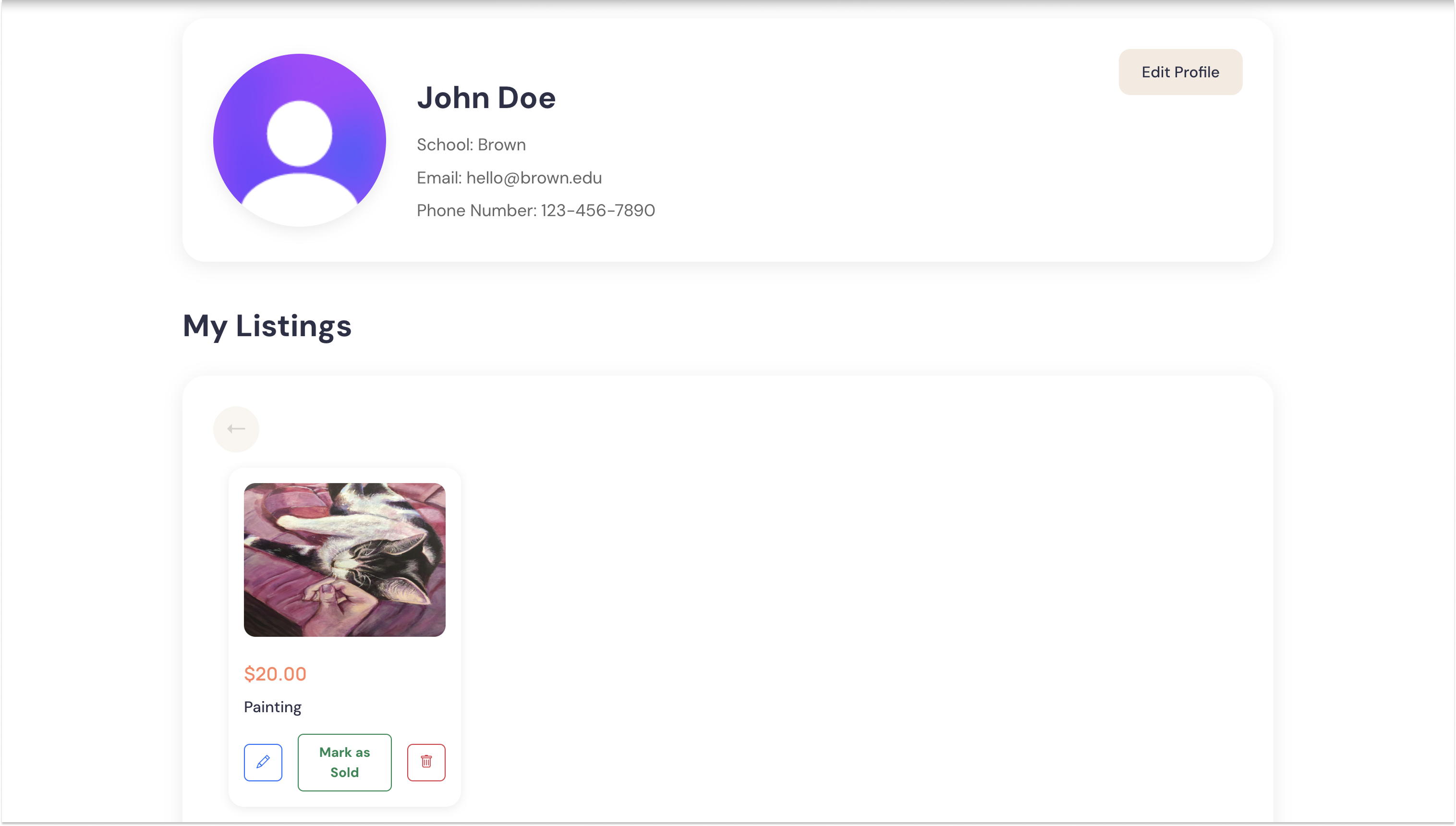Bearly Used
Collaboratively building a full-stack secondhand shopping marketplace for Brown/RISD students
Context
At the end of every semester, Brown and RISD campuses are littered with usable dorm items - mini fridges, storage bins, textbooks - that students no longer need but don’t have the time or energy to pass on. Many students have said that they wanted to give things away or buy used - my teammates and I included. However, existing solutions - like Facebook Marketplace or informal chats - felt too sketchy, cluttered, or inaccessible. Additionally, school facilities workers are likely overworked during move out, and my teammates and I often notice trash recepticles overflowing. We decided to investigate further into this problem by speaking to college friends:
Economic barriers: Students on limited budgets can't access quality items at affordable prices
Social barriers: Students don't have a good mechanism to connect directly with their peers to sell and buy items
Environmental barriers: Donation systems and trash areas are overwhelmed, leading to perfectly good items being disposed in landfills
Thus, we came up with Bearly Used: a verified, school-only online marketplace to make it easy, safe, and sustainable for students to give away, sell, or find dorm essentials. As a product manager and front-end developer, I focused on ensuring the platform didn’t just work, but was also trustworthy, accessible, and built with empathy for real student needs - a marketplace only works if people sign up!
Objective
Build a full stack platform for Brown and RISD students to safely and efficiently buy and sell items.
Audience & Research
My Role
As PM and front-end developer, I led early user research and wrote the project specifications. I defined core features, created personas and user flows, and helped guide our team’s prioritization through impact-focused design. I also helped write weekly progress documentation and facilitated alignment between backend, frontend, and user goals.
User Research
Before writing a single line of code, I recognized the need to deeply understand the problem from multiple perspectives. As product manager, I led our team's user research efforts, conducting interviews with students from diverse backgrounds and living situations to uncover their pain points and preferences when it came to campus reuse.
Thus, I took initative to intervew 4 students with different backgrounds, asking about their experiences with reuse, digital marketplaces, and campus life. Key findings:
- Trust & safety matter: Students are more likely to engage if they know listings are limited to Brown/RISD accounts.
- Overwhelming platforms are limiting: Students often give up on reuse because “it’s too much work” or “I don’t know where to post.”
- Prioritize mobile: Most students said they’d access the app through their phones first and expected a clean interface.
- Design and functionality: Students said they would be more likely to use a more aesthetically pleasing app that had a lot of functionality, such as searching, bookmarking, and filtering.
Armed with this understanding, I translated user needs into a comprehensive product specification that outlined our core features, user flows, and technical requirements.
Design Journey
With a clear understanding of our users and their needs, we began sketching out the platform's architecture and interface. Here is a summary of my roles throughout the project, demonstrating our iterative process:
Week 1: Recs and Specs
- Wrote the project specification after user research
-
Defined features:
- Clerk-based login
- Listing creation with tags & images
- Filtering and searching
- Responsive mobile design
- Built the Create Listing modal with Bootstrap + custom styling
Week 2: Building foundations
- Enabled seller profiles with contact options
- Enhanced UI: hover effects, thumbnails, spacing
- Integrated Clerk auth logic & bridged frontend/backend needs
Week 3: More Features!
- Implemented filtering, pagination, and clean empty states
-
Accessibility audit:
- Alt text
- High color contrast
- Keyboard navigation
- Responsive layouts
Week 4: Final polish & handoff
- Debugged image upload duplication issues
- Wrote README and documented edge cases
- Coordinated final testing and integration
- Outlined ideas for future features
Design Decisions and Tradeoffs
As any product manager knows, building a successful product isn't about implementing every possible feature, but it's about making thoughtful tradeoffs that prioritize what matters most to users.* Throughout our development process, we faced several critical decision points where we had to balance competing priorities.
*We were also on a four week deadline!!! Cutting down scope was integral to our success as well.
Major design tradeoffs
Decision: Implemented email templates instead of in-app messaging
Rationale:
- Students already use email for communication
- Lower maintenance overhead
- 3rd party comms means we didn't have to worry about privacy
- Better accessibility for screen reader users
Decision: Prioritized quick filters over advanced search
Rationale:
- Stakeholders told us they typically browse by category, not search terms
- Simpler UI reduces cognitive load
- Better mobile experience with limited screen space
- Scope :(
Decision: Implemented automatic image compression
Rationale:
- Mobile users have data constraints
- Campus WiFi can be horribly unreliable
- Stakeholders said speed > perfect quality
- Still maintained sufficient quality for users to evaluate items
What We Built
After four weeks of dedicated development, we successfully launched the first version of Bearly Used. The platform included all our core planned features and addressed the key user needs we identified in our research.
Use the arrows to navigate through our features!
Reflections & Looking Forward
Leading this project reinforced my belief that the best products are built with people in mind. By taking the time to understand user needs, prioritizing accessibility, and making thoughtful tradeoffs, we created something that genuinely addresses a community problem.
As product manager, I learned to balance technical constraints with user needs, while my frontend development work showed me how implementation details directly affect accessibility and inclusion. Most importantly, I saw how prioritizing and interacting with stakeholders leads to better design decisions at every stage.
Future possibilities
Although Bearly Used is currently not in use, we hope to build on it someday, as it is still very much a real need! There are several exciting directions for future development:
- Sustainability metrics: Tracking and visualizing the environmental impact of reuse through the platform
- Partnerships: Collaborating with ResLife to integrate with move-in/out processes
- Community features: Adding wishlists and notifications for desired items
I would love to see some version of Bearly Used out there in the future, making school campus culture toward more mindful about consumption and waste - one listing at a time!
Explore the Code
Check out our full repo on GitHub:
GitHub Repo



